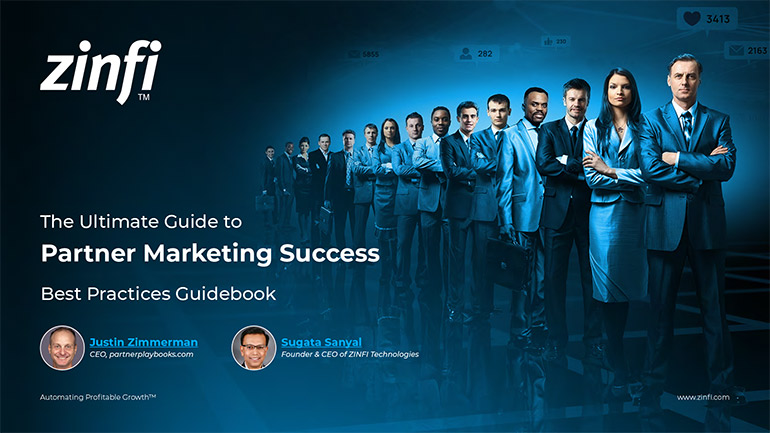Best Practices Articles

Connecting Salesforce CRM to Partner Relationship Management Platform
It has been almost two decades since customer relationship management (CRM) applications began to be adopted as a powerful way to automate sales processes. Meanwhile, we have also seen marketing automation grow rapidly over the past 10 years or so to augment the CRM process experience for direct sales teams. However, the rise of partner relationship management (PRM) SaaS applications like ZINFI’s has demonstrated where an application like Salesforce often falls short. While the development of a Salesforce-like CRM applications that can be customer-configured to address many partner relationship management requirements has been a big step forward, companies still need to invest substantially to customize these solutions successfully. The fact that CRM systems also lack built-in applications essential for PRM means they fall short of providing true Unified Partner Management (UPM). This is why connecting an existing CRM infrastructure like Salesforce to a PRM infrastructure like ZINFI’s makes a lot of sense. In this article, we will explore the core common points of connection between a CRM and PRM.
When you think about sales automation, the first thing that comes to your mind is the word “revenue.” Yes, sales is all about generating revenue by closing deals from the leads that marketing generates. That’s pretty much what a CRM does. CRM takes a bunch of leads that the marketing automation system feeds it, and then allows the sales team to nurture those leads in a systematic way through various sales stages like discovery, qualification, demo, trial, review, agreement, purchase, renewal and support. Sales managers can run various reports across their sales representatives and determine who is most effective, what is working and what needs changing. Automation also allows the elimination of repetitive tasks such as sending out a reminder to a prospect or offering sales collaterals or coming up with automated pricing. There are multiple use cases that a Salesfsorce-like CRM system can address, and its functionality can be extended by using a large number of applications available in Salesforce AppExchange. Some of the standalone applications that plug into Salesforce address other aspect of sales and marketing needs, including rewards, incentives and analytics. This is where ZINFI’s partner relationship management (PRM) comes in.
ZINFI is an AppExchange-approved PRM application provider. While Salesforce also lists a few other PRM applications, unlike those other applications ZINFI’s PRM features an architecture and user interface that closely follows the logic of a CRM system. This allows a seamless flow of data flow back and forth between a Salesforce-like CRM and ZINFI’s PRM.
Let’s explore three core connection points in more detail here:
- Lead Management – As I began this article, I mentioned the primary purpose of a CRM system is to generate revenue by systematically managing the entire sales process from lead to close. The automation of this process is the focus of lead management in a CRM. Now, using a CRM for lead management works great for a direct sales team, but the moment you try to do lead management for channel sales using a CRM, things can quickly get quite complicated and expensive. This is where a purpose-built PRM like ZINFI’s platform can help tremendously by seamlessly connecting to a Salesforce-like CRM system. The integration allows the direct sales team to use the CRM as they always do, while the indirect channel sales and partners can use ZINFI’s PRM for lead management
- Deal Registration – One unique use case for channel sales is protecting an opportunity for a specific partner. We have written multiple articles on deal registration, so I won’t get in the details of it here. Let me just point out that the entire focus of deal registration is to eliminate channel conflict and allow a specific partner to pursue an opportunity from lead to close. Unlike CRMs, partner relationship management (PRM) applications focus heavily on this aspect of channel sales. Effective integration of CRM and PRM allows the direct sales team or even the channel sales team to remain on a Salesforce-like CRM, but all deal registration activities for the partners’ sales reps are carried out in ZINFI’s partner relationship management (PRM) application, which has a variety of tools designed specifically for facilitating deal registration.
- Incentives Management – When it comes to direct sales, there are various sales rewards, gamification tools and other applications available in AppExchange and similar marketplaces. However, when it comes to rewards and incentives for channel sales, standalone applications just don’t do very well. Simply connecting a market development fund (MDF) application to a Salesforce-like CRM can make things quite complicated. A much better approach is to connect your partner relationship management platform to a CRM. In ZINFI’s Unified Partner Management offering, for example, the PRM platform comes with a built-in MDF application. Integration is much easier, and workflow management is significantly more flexible, with easy-to-use tools for adding, moving and changing process flows instantly.
The core benefit of having these workflows separated for direct sales (on a Salesforce-like CRM system) and indirect channel sales (on ZINFI’s PRM platform) is to eliminate dependencies on various parts of the organization. When you have dedicated infrastructure for channel sales in a mixed sales environment, you give significant autonomy to the channel sales team without relying on the direct sales team to make changes to adapt to channel sales requirements. This is important not just from a leads management, deal registration or incentives management perspective, but also from a compliance perspective: Remember, leads now need to stay on two separate “islands” due to the EU’s General Data Protection Regulation (GDPR). We don’t have time here to explore emerging data privacy requirements in detail, but you can think about it like the separation of church and state. You need to create two different infrastructures which can seamlessly connect and speak to each other but can be run independently.
Now, in addition to these core connection points between CRM and PRM, there are many other areas where the two systems can share data, including business planning, contracts management, learning management, configure-price-quote (CPQ) and more. We will explore these connection points in other articles. There is one additional point I’d like to make, though: Connecting a PRM to a CRM makes your life simpler, not just because your direct team can use a Salesforce-like CRM while channel sales uses a PRM—but also because you can address additional workflows in PRM that are difficult to manage on a CRM, such as through-channel marketing automation (TCMA) or partner sales management activities. We will explore these workflows in further detail in other articles.
I hope this article gives you an overview of how a Salesforce-like CRM system can connect to a partner relationship management (PRM) platform in order to maximize the core strengths of these different tools. While in principle there are a lot of similarities between them, each is purpose-built for a specific set of functions. Integrating them allows them to work together like butter and toast.
For more information, please check this article.
Best Practices Guidebook
 The Ultimate Guide to Partner Marketing Success Best Practices
The Ultimate Guide to Partner Marketing Success Best PracticesDownload Guide
 How to Start and Scale Partner Ecosystems Best Practices
How to Start and Scale Partner Ecosystems Best PracticesDownload Guide
 The Evolution of PartnerOps: Past, Present & Future Best Practices
The Evolution of PartnerOps: Past, Present & Future Best PracticesDownload Guide
 Mastering Channel Sales: Strategies, Best Practices, and Growth Tactics for 2025
Mastering Channel Sales: Strategies, Best Practices, and Growth Tactics for 2025Download Guide
 Winning with Partner Advisory Councils: Best Practices for Partner Engagement & Growth
Winning with Partner Advisory Councils: Best Practices for Partner Engagement & GrowthDownload Guide
 The Future of Partner Ecosystems Best Practices
The Future of Partner Ecosystems Best PracticesDownload Guide
 The AI Revolution: How Technology and Talent are Shaping the Future
The AI Revolution: How Technology and Talent are Shaping the FutureDownload Guide
 Top 105 Partner Management Metrics that Matter Best Practices
Top 105 Partner Management Metrics that Matter Best PracticesDownload Guide
 Mastering PRM Integration Best Practices
Mastering PRM Integration Best PracticesDownload Guide
 Building a Sales Partner Portal with Salesforce Best Practices
Building a Sales Partner Portal with Salesforce Best PracticesDownload Guide
 Building and Managing Partner Ecosystems Best Practices
Building and Managing Partner Ecosystems Best PracticesDownload Guide
 Mastering Co-Marketing and Co-Selling Best Practices
Mastering Co-Marketing and Co-Selling Best PracticesDownload Guide
 Transforming Partner Ecosystems Best Practices
Transforming Partner Ecosystems Best PracticesDownload Guide
 Mastering Partner Ecosystems Best Practices
Mastering Partner Ecosystems Best PracticesDownload Guide
 Mastering Partner Onboarding Best Practices
Mastering Partner Onboarding Best PracticesDownload Guide
 Partner Ecosystem Management Best Practices
Partner Ecosystem Management Best PracticesDownload Guide
 B2B Marketing in the Age of Intelligence Best Practices
B2B Marketing in the Age of Intelligence Best PracticesDownload Guide
 Multi-Partner Co-Selling Best Practices
Multi-Partner Co-Selling Best PracticesDownload Guide







